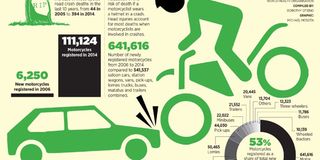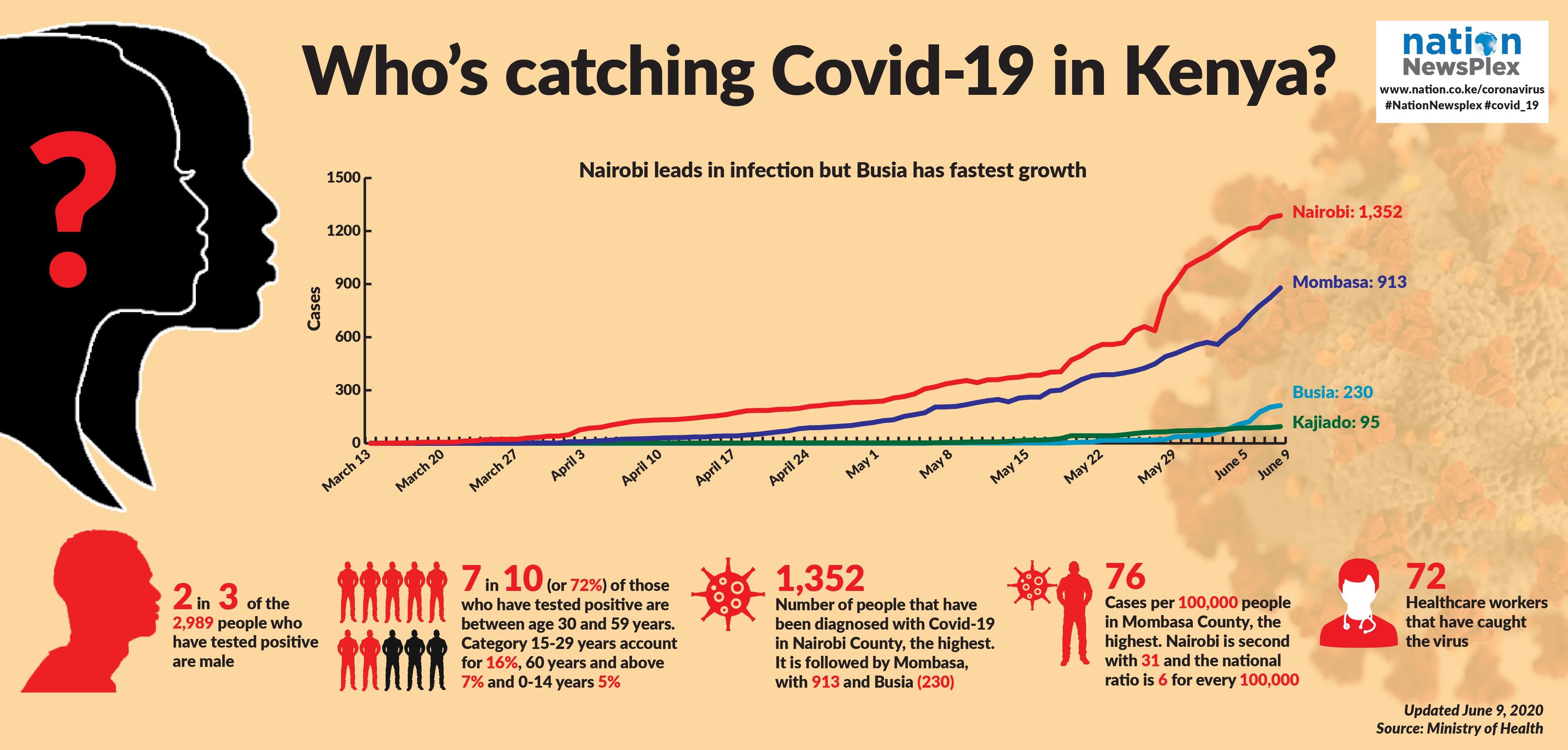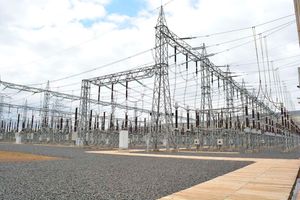Premium
Poorly trained motorcyclists face deadly ride for livelihood

GRAPHIC | MICHAEL MOSOTA
What you need to know:
- Although he had been assured by the doctors that he would soon be on his feet again, he says he will never risk his life on the road again.
- In the five years that Mr Leonard Onyango has been a motorcycle operator he has been involved in three crashes.
- "Human factor is of critical importance to any efforts to improve road safety for powered two wheeler riders," the report states.
Joseph Maina, 27, went into the boda boda business after being trained to ride by a friend for two days.
“I was taught the basics of riding the motorbike by a close friend for only two days [for] which I paid him Sh500. On the third day, I hit the road and ferried passengers to various destinations,” says Maina who lives in Nakuru.
His business was running smoothly although he avoided the central business district (CBD) where he said the traffic was a bit confusing, a situation which required someone with experience and probably one who had attended a training school.
“But after two week I realised I could venture in to the CBD since I had not been involved in any accident,” said Maina.
However, as fate could have it, he was involved in an accident one evening at a roundabout as he tried to overtake a slow-moving trailer.
“I had been called by a customer to rush him to the hospital and I thought it better to overtake the slow-moving trailer to avoid losing the customer. Unluckily, I was hit from behind and was shoved across the road to the pedestrian walking pavement. I was very lucky because I was not carrying anyone at the time and I was not pushed to the other lane of the highway. The helmet also played a great role in protecting my head,” he says.
But Maina sustained serious injuries on his legs and hands, and minor injuries on his face. Although he had been assured by the doctors that he would soon be on his feet again, he says he will never risk his life on the road again.
“The best thing is for someone to undergo training from a training school, even if it is expensive, than to lose life or remain crippled forever over a few shillings,” he says.
The number of motorcycle deaths in Kenya has been increasing in the last 10 years, from as low as 44 in 2005 to the current 391 deaths in 2014, according to data from the National Transport and Safety Authority (NTSA). This is about an eight-fold increase in deaths resulting from motorcycle crashes.
While deaths due to motorcycles are rising there is a reduction of fatalities due to pedal cyclists in the last 10 years. Deaths among cyclists dropped by 66 per cent
Duncan Kibogong, a deputy director of Safety Strategies and County Committees at NTSA, affirms that most motorcyclists are not formally trained. “In every village there are at least 10 motorcyclists, so we cannot monitor everyone because NTSA enforcement officers are few,” he says.
Mr Caleb Were says most of them have driving licenses but this does not mean that they have undergone driving lessons. “There are those who transport passengers without licenses and they break traffic rules because they do not know them and give us a bad name,” he says.
A spot-check in Nakuru found that a course of motorcycling lessons costs about Sh5,500.
Not only are more motorcyclists dying but their share of total traffic deaths is also increasing steadily. In 2005, motorcyclists and pillion drivers made up six per cent of traffic road accidents deaths. This percentage increased more than three-fold, to 22 per cent in 2014.
The next highest increase in deaths, 69 per cent, was among pillion passengers. Deaths among passengers, drivers and pedestrians went up by less than 10 per cent while overall deaths from road crashes went up by 15 per cent.
Part of the increased contribution of motorcycles to crash deaths is down to their increasing share of vehicles that have been registered in the last 10 years. About 53 per cent of vehicles newly registered between 2006 and 2014 were motorcycles, followed by station wagons with 21 per cent and saloon cars with 10 per cent.
SURVIVED THREE CRASHES
During that period, motorcycle registration increased almost fifteen hundred per cent, while the registration of saloon cars went up by about only seven per cent in comparison.
Motorcycles have become death traps, with NTSA Director General Francis Meja attributing the rise in traffic deaths by the two-wheelers to several issues. He says the main cause of crashes by motorcycles is failure to obey traffic rules.
"They jump lights, drive at high speed, overtake from the wrong side and carry more than the required number of passengers. This is impunity and general lack of discipline,” he told Nation Newsplex in an interview.
Mr Arthur Ndung’u the Chairman of Bodaboda operators in Gilgil Sub-County shares Mr Kibogong and Mr Meja’s views.
In the five years that Mr Leonard Onyango has been a motorcycle operator, he has been involved in three crashes. He sustained a serious eye injury in one of the crashes, hurt his knee in another and was lucky to escape with minor bruises in the third crash.
During an interview at the Balozi Junction on the busy Likoni Road in Nairobi, Mr Onyango says he has a mark on his left eyelid after he was involved in a crash in June last year. He said he collided with a man riding a bicycle.
“I was cut on the eye and the helmet broke when I fell on the road. The bicycle rider was injured on the forehead,” he says.
He was rushed to South B Hospital where he was stitched and discharged.
He was involved in another crash afterwards with a private car. “I had approached Diamond Park 1 Estate when a motorist turned to enter the estate without indicating. I rammed the driver’s side and fell into a ditch,” he recalls.
WESTERN KENYA DANGER
He says he was lucky to escape with minor bruises and opted to settle the matter with the motorist without involving the police. In a third incident involving a crash with a vehicle, he hurt his knee, which he claims still hurts to date.
Mr Onyango is lucky to have survived the crashes, with reports indicating that the number of motorcyclists involved in crashes is rising by the day.
In the Global Status Report on Road Safety 2015 by the World Health Organisation (WHO), motorcyclists are grouped together with cyclists and pedestrians as the most vulnerable group that account for about half of traffic deaths worldwide.
Motorcycles are preferred in rural areas as they are not only affordable but also ply routes that are not accessible by vehicles.
They are fast and the most effective means to beat traffic jam in urban areas. They are also affordable to buy, so most people can purchase them and use them to ferry passengers.
Mr Meja says a large number of motorcycle crashes happen in major towns in western Kenya, including Kisii, Nakuru, Eldoret and urban centres in Nyanza.
He says motorcyclists and their passengers are at increased risk of being involved in a crash because they don’t have special lanes.
"They also share the road with other bigger, heavier vehicles, [which] also at times don't respect the motorcyclists," he says.
SUBSTANDARD HELMETS
Mr Onyango echoes Mr Meja’s sentiments, saying a stereotype that bodaboda operators are reckless drivers exists, hence other motorists do not respect them. He says most motorists do not indicate that they are turning and only do so at the last minute.
“If a bodaboda is following such a motorist at high speed then they are likely to be hit by that driver or swerve to avoid a crash and be hit by an oncoming vehicle,” he says.
Most bodaboda operators do not wear helmets and if they do, tend not to fasten them, meaning they could fall off in case of a crash. Passengers too are always at risk as they do not wear helmets.
The WHO report states that wearing a standard, good quality helmet can reduce the risk of death by 40 per cent and the risk of serious injuries by 70 per cent.
This means a motorcyclist could be wearing a helmet at the time of a crash but be still at risk because of its substandard quality.
The report also states that most motorcycle deaths are from head injuries and that only 44 countries worldwide – excluding Kenya – have good helmet laws covering all users including children.
According to Mr Meja, a majority of motorcyclists in Kenya use helmets not of the quality set by the Kenya Bureau of Standards (Kebs), putting their lives and those of their passengers at risk.
Dr Kibogong says that NTSA worked with Kebs and other stakeholders to revise the helmet standards to meet UN recommendations. “Since February KEBS have been inspecting to ensure that imported helmet and those manufactured locally meet UN standard. But substandard ones still make it through Kenya’s porous borders,” he says.
Most motorcyclists are not aware that they need to have helmets that meet a certain standard. “To me a helmet is a helmet, I am not aware that there is one that am supposed to buy because it meets certain standards,” says Mr Onyango.
SIDEWALKS AND LANES
A report released by the International Motorcycle Manufactures Association (IMMA) during the recently concluded 2nd Global Conference on Road Safety held in Brasilia, Brazil in November shows that human error is a major cause of road crashes worldwide.
"Human factor is of critical importance to any efforts to improve road safety for powered two wheeler riders," the report states.
The IMMA recommends that motorcycles be factored in infrastructure or road designs to minimise conflicts with larger and heavier vehicles.
At the end of the conference, governments adopted the Brasilia Road Safety Declaration. Governments committed to, among other things, improve laws and enforcement on risks such as speeding, drinking and driving, failing to use seat-belts, motorcycle helmets and child restraints.
Governments also undertook to make roads safer through infrastructural modifications, such as sidewalks and lanes separating cyclists and motorcyclists from vehicles.
These improvements count towards achieving the target of reducing traffic deaths by half, as per the Sustainable Development Goals (SDGs).





